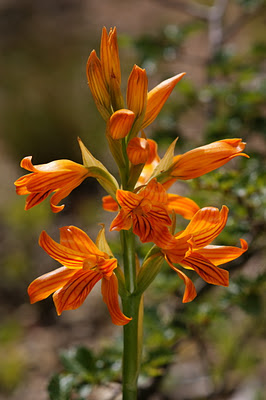Finally we can announce the arrival of our book!
We're sorry for the long silence but we wanted to know just when the book was going to be available. Last minute setbacks with the publishing meant we missed the Christmas launch we'd hoped for - but, we have a copy in our hands right now and our publisher, IB Tauris, have done a superb job. The colours are great, printed onto good art paper and the overall quality excellent. We're delighted and sincerely hope anyone who decides to buy the book will be too. The title has changed slightly to Flora of the Silk Road.
Publishing any book always takes a lot of time and we appreciate the patience of those logging onto this blog to find out when it was going to arrive. It can now be bought direct from IB Tauris, price £35, or as a pre-order from other online retailers such as NHBS for a bargain £30, which is a steal for a 416 page book weighing over 3 kilos. The front cover features the gorgeous Gentiana arethusae at Tianchi Hai in Yunnan, the back cover a stunning carpet of golden Crocus korolkowii, near Dushanbe, Tajikistan. Inside we feature 545 species with over 700 images.
For those wanting a signed copy please get in touch with us by email and we'll see if we can arrange. Anyone coming on our tours this year will be able to buy one direct from us in Turkey - please check both our website www.viranatura.com and www.greentours.co.uk
We intend to offer a series of Silk Road flower tours beginning with Turkey and Kyrgyzstan in 2016 and China in 2017. Chris will also be giving a number of talks this year to promote the book, the first on 14th January for the British Society for Asian Affairs and another for the Royal Geographical Society on the 20th April. Others will follow. Work is already well advanced on our next two book projects - photographic guides to the Flowers of the Lycian Way & SW Turkey and Flowers of the Kackar & NE Turkey. Both will contain around 500 species and we're optimistic about a 2016 delivery date. Our intention is to produce a series of Turkish flora guides over the next few years to cover much of the country.
Enjoy the flowers.
Chris and Basak
Colchicum cilicium, near Mersin, Turkey
We're sorry for the long silence but we wanted to know just when the book was going to be available. Last minute setbacks with the publishing meant we missed the Christmas launch we'd hoped for - but, we have a copy in our hands right now and our publisher, IB Tauris, have done a superb job. The colours are great, printed onto good art paper and the overall quality excellent. We're delighted and sincerely hope anyone who decides to buy the book will be too. The title has changed slightly to Flora of the Silk Road.
Publishing any book always takes a lot of time and we appreciate the patience of those logging onto this blog to find out when it was going to arrive. It can now be bought direct from IB Tauris, price £35, or as a pre-order from other online retailers such as NHBS for a bargain £30, which is a steal for a 416 page book weighing over 3 kilos. The front cover features the gorgeous Gentiana arethusae at Tianchi Hai in Yunnan, the back cover a stunning carpet of golden Crocus korolkowii, near Dushanbe, Tajikistan. Inside we feature 545 species with over 700 images.
For those wanting a signed copy please get in touch with us by email and we'll see if we can arrange. Anyone coming on our tours this year will be able to buy one direct from us in Turkey - please check both our website www.viranatura.com and www.greentours.co.uk
We intend to offer a series of Silk Road flower tours beginning with Turkey and Kyrgyzstan in 2016 and China in 2017. Chris will also be giving a number of talks this year to promote the book, the first on 14th January for the British Society for Asian Affairs and another for the Royal Geographical Society on the 20th April. Others will follow. Work is already well advanced on our next two book projects - photographic guides to the Flowers of the Lycian Way & SW Turkey and Flowers of the Kackar & NE Turkey. Both will contain around 500 species and we're optimistic about a 2016 delivery date. Our intention is to produce a series of Turkish flora guides over the next few years to cover much of the country.
Enjoy the flowers.
Chris and Basak
Colchicum cilicium, near Mersin, Turkey
Corydalis rupestris & Hummingbird Hawkmoth, Koorhang, Iran
Iris westii, Syria
Meconopsis aculeata, Lahual Valley, NW India
Primula sikkimensis (yellow) & secundiflora, Tianchi Hai, Yunnan
Rhododendron hodgsonii, Dzongri, Sikkim




















































